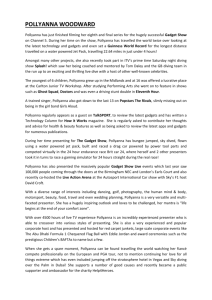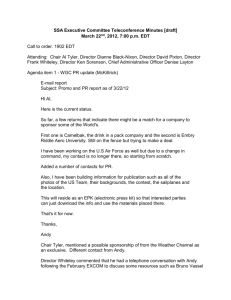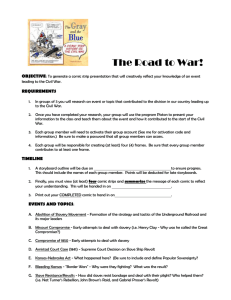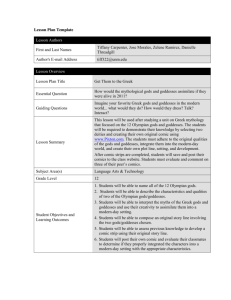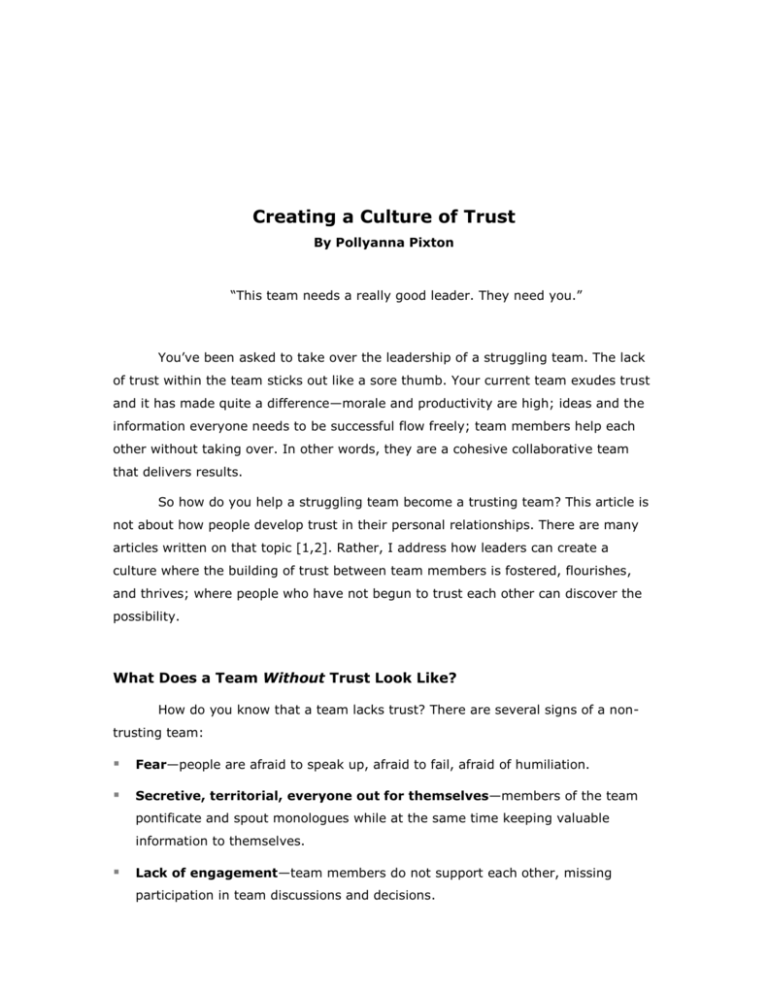
Creating a Culture of Trust
By Pollyanna Pixton
“This team needs a really good leader. They need you.”
You’ve been asked to take over the leadership of a struggling team. The lack
of trust within the team sticks out like a sore thumb. Your current team exudes trust
and it has made quite a difference—morale and productivity are high; ideas and the
information everyone needs to be successful flow freely; team members help each
other without taking over. In other words, they are a cohesive collaborative team
that delivers results.
So how do you help a struggling team become a trusting team? This article is
not about how people develop trust in their personal relationships. There are many
articles written on that topic [1,2]. Rather, I address how leaders can create a
culture where the building of trust between team members is fostered, flourishes,
and thrives; where people who have not begun to trust each other can discover the
possibility.
What Does a Team Without Trust Look Like?
How do you know that a team lacks trust? There are several signs of a nontrusting team:
Fear—people are afraid to speak up, afraid to fail, afraid of humiliation.
Secretive, territorial, everyone out for themselves—members of the team
pontificate and spout monologues while at the same time keeping valuable
information to themselves.
Lack of engagement—team members do not support each other, missing
participation in team discussions and decisions.
A Culture of Trust
By Pollyanna Pixton
Page 2 of 9
Accelinnova.com
Defensive and negative—closed body language, never saying a good word
about other team members or the tasks at hand.
Judgmental and condescending—ideas are dismissed without consideration or
criticized unfairly.
Passive-aggressive behavior and lack of integrity—in meetings people
agree to one thing and outside the meetings say and do another.
Impatient, people are easily agitated—tension in every working encounter, at
the same time they lack initiative.
Gossip runs rampant, as does complaining—team members talk behind each
others’ backs, mean-spirited humor instead of healthy, fun humor.
It is quite a challenge to take on such a team and lead them to trusting each
other, especially when you are faced with the fact that, as a leader, you cannot
change people. You can’t make people trust each other. Ordering people to trust
each other just doesn’t work.
Still, you want to take on the leadership of this team. You know many of the
team members. They are a talented group and have produced great results on other
teams. The project they are working on is important to the company and you figure
you can help. But there is one more question you need to consider.
“Pollyanna, can I talk to you about one my team members who is giving me
trouble?”
“Sure.” Then comes my first question, “Do you trust them?” And the usual
reply? “No.” That’s an issue. People know when you don’t trust them. They really
know when their leaders don’t trust them. As Ricardo Semler asks in his book, The
Seven Day Weekend, if you don’t trust the people on your team, why are they on
your team? For that matter, why are they in your organization?
Before you make a decision about leading this team, ask yourself one final
question, “Can I trust everyone on this team?” You may not know all of them well,
but you must make sure there is no one on the team you distrust.
Your answer to this question is yes so you accept the leadership role for this
team. Now what do you do?
© Copyright, 2008, P. Pixton. All rights reserved.
A Culture of Trust
By Pollyanna Pixton
Page 3 of 9
Accelinnova.com
Creating a Culture of Trust
“Just pick people who are trustworthy.” I get this answer at times from
colleagues.
“And, how often do leaders actually get to do that?” I reply.
You are assigned a project — you pick people you know are good, competent
and trustworthy; give them responsibility to deliver within the constraints; and they
become a trusting, high-performance team, all within 15 minutes. You may have this
experience once in your lifetime—or not. Realistically, like it or not, we are given our
team members with all their foibles, shared history, and excess baggage.
Can the Team Trust Each Other?
“What do you do, Pollyanna, when there is one person on a team that no one
trusts?” “Are you sure they don’t trust him?” I answer. “Is it a lack of trust or has
trust been broken?”
Broken trust is like a cut rope. There are many strands, wound together that
give the rope its strength. Once cut, repairing the rope requires matching each piece,
strand for strand. Not only does it take time, the rope will never be the same and will
not have the strength the original rope had. Can a distrusted person repair his
relationship with the rest of the team? Does he want to? And does he have the skills
to do so? Possibly, but the time and effort to do so is very high and the results might
not be optimal or even acceptable.
However, there may be no broken trust in the team, just lack of trust, which
can be developed. You need to find out. Take the time to make some observations
and assessments to see how deep the distrust might be and identify some possible
causes.
Interview each team member in confidence. Ask about how they like their
work on the team, what’s working and what’s not. If they could fix what’s not
working, what would they do and why? Ask what obstacles are getting in their way
for their individual success and their team’s success. Do they feel like the team can
deliver the expected results? And if not, what can be done to improve their chances?
Check to see if they feel the right people are on the team, that everyone has the
knowledge, experience and commitment to complete the project. Most importantly,
© Copyright, 2008, P. Pixton. All rights reserved.
A Culture of Trust
By Pollyanna Pixton
Page 4 of 9
Accelinnova.com
ask if they trust everyone on their team. They may be uncomfortable answering such
direct questions with their new leader. Listen for the ‘ring of truth’ in what people say
and make note of what they leave out of your conversation.
Walk the floor. Watch and listen to how the team works. Is one person talking
all the time? Are people ignoring one or more of their fellow team members? Are
there consistent put-downs or constant dismissals of one person’s ideas? Spend
time in the break room. How do they interact there? Do they avoid someone? Do
they talk about ideas? Do they avoid eye contact with some of their team members?
Listen to the interactions within the team and with people outside the team, and look
at their results and progress.
Look for trends or threads in your conversations and observations. Did you
sense any red flags or unauthentic answers? Did one name come up again and again
as someone who did not deliver as he said they would? Did one person consistently
withhold information? Was he constantly noted as hard to get along with, never
listening, saying one thing and doing another? The issue of distrust seems to point to
one person and a hard decision faces you.
You have two choices: Keep this person involved with the team at some level
or remove him. What is your first response? Your intuitive answer may be the right
one, but before you act, answer a few more questions. How valuable is he to your
team, to your project? Can your team succeed without him? What are the negative
impacts if he leaves? Or if he stays?
“Apply the ‘vacation test’,” advises my colleague, Niel Nickolaisen. “See how
the team does when the ‘problem’ team member goes on ‘vacation’ for a few days.”
Take this person off the team and give him something else to do. Place him
somewhere where he cannot interfere with the day-to-day functions of the team.
What happens to the team productivity; their motivation; their morale?
If you come to the conclusion that the team benefits from him off the team,
then make the move as soon as possible. But what if you need to keep him involved
with the team at some level. Then what do you do?
Again you have two choices: Ask the team to integrate this person in some
way into the project, or create a ‘one person island’ inside the team. Both are
difficult and will take time and effort to make happen. Sit with the team without this
person and ask them how they can work with him? What team norms would have to
© Copyright, 2008, P. Pixton. All rights reserved.
A Culture of Trust
By Pollyanna Pixton
Page 5 of 9
Accelinnova.com
be established to make it happen? What would they need to be successful with him
on the team? What do they need from you to make it happen? What does the team
want you to do when the disruptive person interferes too much with the other team
members? Come to an understanding that, while the team must work with this
disruptive person, they do not have to view them as a team member. They can
collaborate without him. They must make decisions with this person only when it
involves his work.
Everyone must understand that sabotaging the disruptive person is not
acceptable and would be seen as sabotaging the team efforts. Ensure that the team
will be measured as a team, not as individuals. While they can’t control the
disruptive person in their midst, they can use his knowledge and experience to
succeed as a team.
You have resolved the situation with the difficult person and now your team
issues are solved? You have a trusting, productive team? Not quite!
Steps to Build a Culture of Trust
As the leader, your role, style and behavior will lay the ground work for
building a culture of trust. There are a few things you need to pay special attention
to about you. Authenticity is essential—your team will see right through you if you
are not authentic (missing your own ‘ring of truth’), and their lack of trust will
continue. Be trustworthy and own up to your own foibles, history, and mistakes.
Share all information with the team and when you can’t, tell them why. You have to
show you trust your team—first.
Give up command and control leadership and stop micromanagement. Telling
people what to do and how to do it shows a lack of trust. If you trust people, you
know they will do what they say they will do and they know best how to do it.
Micromanagement sends a message that you do not trust those you are leading.
Trust me; your leadership will be tested by your team. Team members will
come back several times to see if you will rescue them, fix it for them, tell them
what to do and how to do it, if you will really accept mistakes and whether you
genuinely trust them to deliver. They will watch carefully and test your
trustworthiness. Will you listen? Will you give them the information they ask for? Will
you admit your mistakes, will you be honest?
© Copyright, 2008, P. Pixton. All rights reserved.
A Culture of Trust
By Pollyanna Pixton
Page 6 of 9
Accelinnova.com
Now focus on creating a culture where the team can build trust among
themselves.
So what can you, as the leader, do? Use the following steps:
Remove debilitating fear
Use team-based measurement
Ask for small deliverables in short iterations
Expect success, allow mistakes
Take the fun out of being dysfunctional
Let’s take a closer look at each of these steps.
Remove Debilitating Fear. Without the team generating ideas and
solutions, progress will be slow and perhaps impossible. Debilitating fear is what
keeps team members from expressing their questions, solutions, analysis, and
investigations. They are afraid of humiliation, ridicule, loss of respect, and—the
deepest fears—loss of their position, pay, and perhaps their job. Fear results in
paralysis and catastrophizing (making things seem worse than they are). There are
ways to mitigate fear. As a leader, acknowledge openly with the team the fear that
you feel is in the team. Imagine, reframe and describe the team culture as a will be
as a trusting team. Remind the team that they have choices in how they respond to
the fear: Ask them to give the team a chance and bring their ideas to team meetings
or simply try their ideas out on other team members one-on-one. Practice the steps
to change: celebrate resistance, figure out what to be—not what not to be, and take
small steps.
Use Team-based Measurements. Measuring individual performance is a
deterrent to collaboration and teams working together. Often, if individuals are
measured on their own performance, they don’t care how well the rest of the team
does—they’ll look out for themselves first. To change this dynamic, measure the
team, not the individuals. This motivates the team to work together and help each
other deliver a team success.
Ask for Small Deliverables in Short Iterations. Ask the team for rapid,
incremental deliveries—small successes where they can see progress and successful
results as a team. Let them make decisions on how they will do this, on how they will
© Copyright, 2008, P. Pixton. All rights reserved.
A Culture of Trust
By Pollyanna Pixton
Page 7 of 9
Accelinnova.com
do their own work and how they will work together. They don’t need you to tell
them. Step back and let the team decide.
Expect Success; Accept Mistakes. Stress the motto ‘Fail Early, Fail Fast!’
People learn from their mistakes. Right now, your team may be worried about taking
a risk and failing. Sure, removing disruptive fear might help. Most important is you
protecting them and your organization. Create a way for the team to fail safely.
What does that mean? First, you don’t want them to be embarrassed in front of your
customers, in front of organizational leaders, and in front of other teams. Add a step
in the processes (or, better still, suggest they evaluate adding a step) where they
can walk through their results before they go outside of their team.
Take the ‘Fun’ Out of Being Dysfunctional. Ignore unprofessional
behavior. What do you do about those who are ‘gaming the system’ where team
members leverage the leader to discredit a team member? This does not often exist
in a ‘healthy’ team, one that is collaborative, understands and respects each other’s
contribution, remains focused, and has ownership. But you don’t have that—yet. To
get there—take the ‘fun’ out of dysfunctional. Remove the reward people are getting
for playing games within the team. When someone causes distractions, such as
asking rhetorical questions with no real purpose—where they are trying to impress
you with the ‘right answer’, or embarrass you if you made a mistake—ignore this
behavior. Stand quietly and do not say a word. Or, look to others in the room and
change the subject. Remember, negative attention can be a reward.
Helping the Process Along
The team’s efforts to build trust will have its ups and downs. There are a few
things you can do to help that process move forward.
Focus on Purpose. Teams don’t get to do whatever they want, whenever they
want. But they do need time for exploration of their ideas and possible solutions.
When chaos has gone on too long, step in and ask questions to help the team get
back on track. Ask, don’t tell. The team does not need to be told what direction
to go, they need assistance in discovering their own direction as it relates to their
current project.
© Copyright, 2008, P. Pixton. All rights reserved.
A Culture of Trust
By Pollyanna Pixton
Page 8 of 9
Accelinnova.com
Protect the Team Boundaries. Be your team’s advocate—go to bat for them,
get the team what they need to succeed, and don’t let the distractions of
corporate bureaucracy and politics creep into their work environment.
Stay Positive. The team will need acknowledgement, feedback, and recognition.
Affirm what is working. Don’t dwell on past failures or anything that could
possibly be interpreted as judgmental. Negative feedback will be blown out of
proportion and its effects may take a long time to repair.
The Lack of Trust ‘Price Tag’
Why should you spend the effort in creating a culture of trust? Look at the
transaction costs, the number of decisions and/or actions you make interacting with
someone or something. How long does it take you to get a task done by someone
you don’t trust? There is the preparation time where you figure out how to approach
this person and how to clearly state your request. In the conversation, how many
times did you say the same thing in different ways to ensure you were heard? How
many times did you check to make sure that he correctly heard what you said? How
often did you check to see if he will deliver what and when he said he would? The
transaction costs of distrust are high. In a non-trusting environment, people spend a
large amount of time protecting themselves. No wonder teams without trust exhibit
low productivity.
Summary
We know teams deliver great results when they take ownership. After working
with a team on setting goals and objectives, leaders must step back and let the team
work. You can’t do this without trust—it is essential in engaging teams, retaining
talent, fostering innovation, creating great working environments, and delivering
results. When the trust goes out of a team, what can a leader do?
Hard as it may be, you must decide what to do when one member of the
team has broken trust with the others. It really does not matter how it happened. To
keep such a person on your team is costly. You must decide if it is better to take the
person off the team or not. If you keep that person, you and the team must decide
how to work with that person.
© Copyright, 2008, P. Pixton. All rights reserved.
A Culture of Trust
By Pollyanna Pixton
Page 9 of 9
Accelinnova.com
As the leader, make sure you trust or can build trust with everyone on your
team. Be transparent and show you are open to new ideas and different ways of
thinking. Practice collaborative leadership—give up micromanagement and command
and control.
Leaders can not make people trust each other, but they can create a culture that
encourages trust and where trust flourishes and thrives.
[1] The Decision to Trust, Robert F. Hurley, Harvard Business Review, September
2006.
[2] Successful Team Leadership Is Built on Trust, Richard Benson-Armer and Darryl
Stickel, IVEY Business Journal, May/June 2000.
About Pollyanna Pixton
An international collaborative leadership expert, Pollyanna Pixton developed the
models for collaboration and collaborative leadership through her thirty-five years of
working inside and consulting with corporations and organizations. She helps
companies create workplaces where talent and innovation are unleashed—making
them more productive, efficient, and profitable. Pollyanna is a founding partner of
Accelinnova, president of Evolutionary Systems, director of the Institute for
Collaborative Leadership, and co-author of forthcoming book, Stand Back and
Deliver, Tools for the Agile Leader, available from Addison-Wesley early 2009. She
co-founded the Agile Project Leadership Network (APLN) and chaired the Agile 2006
Leadership Summits in London and Minneapolis. Contact Pollyanna at
ppixton@accelinnova.com.
© Copyright, 2008, P. Pixton. All rights reserved.

